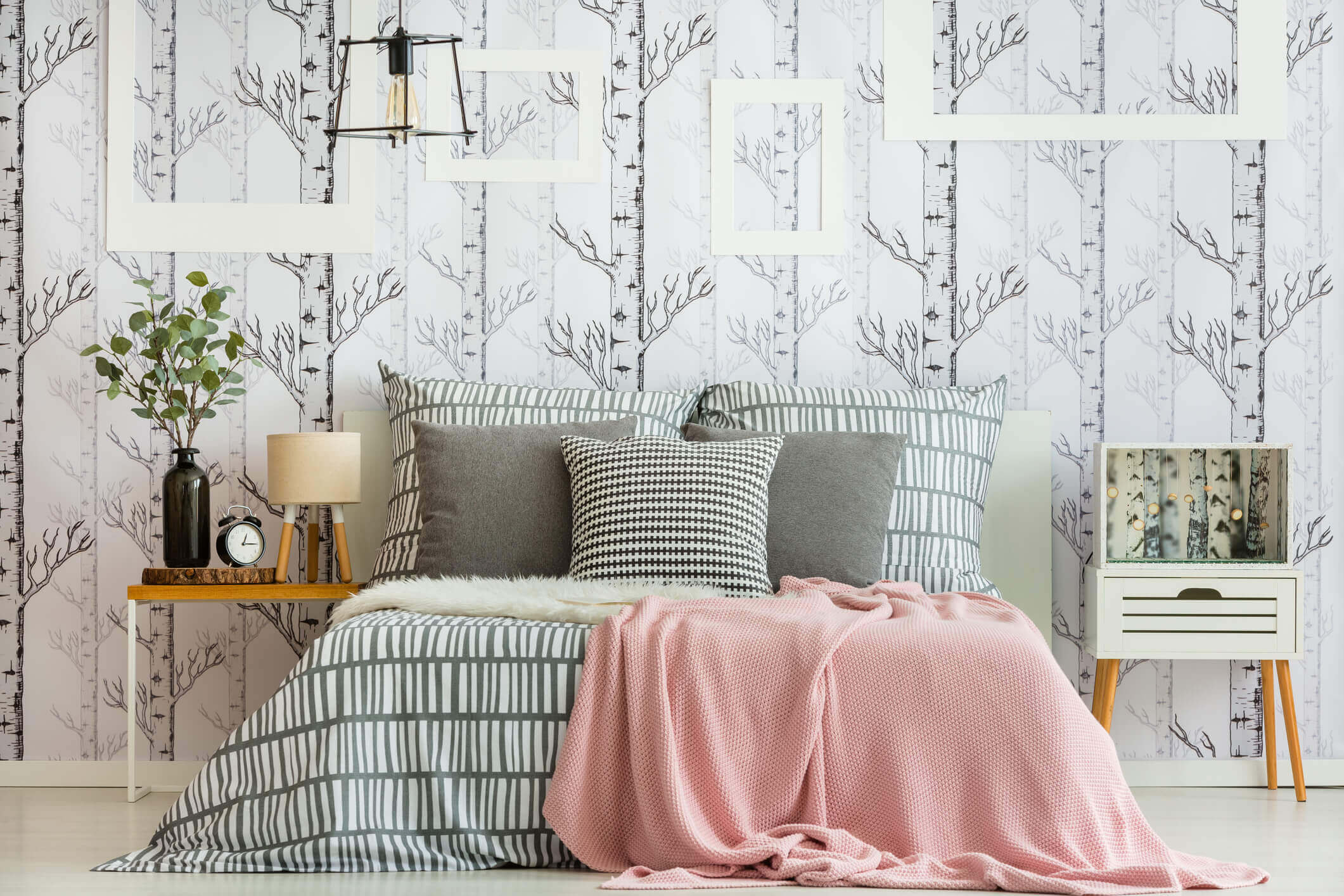The Science of Calm: Calming Wallpaper For Bedrooms

Creating a peaceful and serene bedroom is more than just choosing aesthetically pleasing colors and furniture. It’s about understanding the psychological impact of design elements and how they influence our mood and well-being. The science behind calming spaces is rooted in how our brains respond to visual cues and sensory experiences.
The Impact of Color
Color psychology plays a crucial role in creating a calming atmosphere. Certain colors have been shown to evoke specific emotions and influence our mental state.
- Blues: Often associated with the sky and ocean, blues promote feelings of tranquility, peace, and serenity. They can lower blood pressure and heart rate, creating a sense of calm and relaxation.
- Greens: Representing nature and growth, greens are known to have a calming effect on the mind. They can reduce stress and anxiety, promoting feelings of balance and harmony.
- Purples: Often linked to spirituality and royalty, purples can induce feelings of calmness, introspection, and creativity. They can also help to create a sense of luxury and sophistication.
The Influence of Design Elements
Beyond color, various design elements contribute to a calming environment. These elements work in synergy with color to create a holistic sense of peace and tranquility.
- Natural Textures: Incorporating natural materials like wood, stone, and bamboo brings a sense of grounding and connection to nature. These textures create a feeling of warmth and comfort, promoting relaxation and reducing stress.
- Soft Curves: Sharp angles can create a sense of tension and anxiety. In contrast, soft curves and rounded shapes promote a sense of fluidity and ease. They create a welcoming and comfortable atmosphere, fostering feelings of relaxation and security.
- Minimalist Aesthetics: Clutter and visual noise can be overwhelming and contribute to feelings of stress and anxiety. Minimalist design principles, characterized by clean lines, simplicity, and a focus on essential elements, promote a sense of calm and order. This minimalist approach allows the mind to rest and focus, creating a tranquil environment.
Calming Spaces: Examples from Spa and Meditation Environments
The principles of color psychology and design are effectively employed in spa and meditation spaces to create a serene and restorative environment.
- Spa Treatments: Spa interiors often feature calming colors like blues and greens, combined with natural textures like wood and stone. The use of soft lighting, gentle music, and aromatherapy further enhances the sense of tranquility and relaxation.
- Meditation Rooms: Meditation spaces prioritize simplicity and focus. They often feature minimalist design, with neutral colors and natural elements. The absence of distractions allows individuals to fully engage in their meditation practice, promoting a sense of peace and mindfulness.
Calming Wallpaper Styles

Transforming your bedroom into a tranquil oasis starts with the right backdrop. Calming wallpaper can create a soothing ambiance, promoting relaxation and restful sleep. Let’s explore various styles that can bring serenity to your sanctuary.
Nature-Inspired Wallpaper
Nature-inspired wallpapers evoke a sense of peace and tranquility. They often feature serene landscapes, such as forests, oceans, or skies, creating a calming visual experience. These designs can transport you to a peaceful setting, reducing stress and promoting a sense of well-being.
Examples:
- Forest Scenes: Imagine a wallpaper depicting a lush forest with towering trees, dappled sunlight filtering through the leaves, and a winding path leading into the depths. This type of wallpaper can bring the tranquility of nature indoors, creating a sense of serenity and grounding.
- Ocean Views: A wallpaper with a calming ocean scene, such as a tranquil beach with gentle waves crashing on the shore or a breathtaking sunset over the horizon, can evoke a sense of peace and serenity. The rhythmic movement of the waves can be mesmerizing, promoting relaxation and mindfulness.
- Sky Patterns: Wallpaper featuring abstract representations of the sky, such as swirling clouds, starry nights, or delicate wisps of smoke, can create a calming and ethereal atmosphere. The vastness of the sky can inspire a sense of awe and wonder, promoting a sense of peace and tranquility.
Abstract and Geometric Wallpaper
Abstract and geometric wallpapers offer a modern and minimalist approach to calming design. They feature soft gradients, subtle patterns, and clean lines, creating a sense of order and balance. These designs can be calming and visually appealing, promoting a sense of focus and tranquility.
Examples:
- Soft Gradients: Wallpaper with gentle transitions from one color to another, creating a subtle and calming effect. The gradual change in color can create a sense of depth and dimension, promoting a sense of peace and tranquility.
- Subtle Patterns: Wallpaper featuring delicate geometric patterns, such as repeating squares, triangles, or circles, can add visual interest without being overwhelming. The repetition of the pattern can create a sense of rhythm and order, promoting a sense of calmness and focus.
- Clean Lines: Wallpaper with clean lines and sharp angles can create a sense of order and structure, promoting a sense of calm and focus. The simplicity of the design can be calming and visually appealing, creating a sense of peace and tranquility.
Minimalist Wallpaper
Minimalist wallpapers prioritize simplicity and serenity. They often feature solid colors, subtle textures, and a lack of intricate details, creating a clean and calming atmosphere. These designs can promote a sense of peace and tranquility, allowing your mind to rest and recharge.
Examples:
- Solid Colors: Wallpaper in muted tones like soft blues, greens, or grays can create a calming and serene backdrop. The absence of patterns or distractions can promote a sense of peace and tranquility, allowing your mind to relax.
- Subtle Textures: Wallpaper with subtle textures, such as linen, woven, or embossed designs, can add visual interest without being overwhelming. The tactile nature of the texture can create a sense of comfort and warmth, promoting a sense of peace and tranquility.
Textured Wallpaper
Textured wallpapers add depth and dimension to your bedroom walls, creating a tactile and visually appealing experience. They often feature materials like linen, woven fabrics, or woodgrain, providing a natural and calming feel. These designs can promote a sense of comfort and warmth, creating a cozy and inviting atmosphere.
Examples:
- Linen Wallpaper: Linen wallpaper features a natural and organic texture, creating a sense of warmth and comfort. The subtle variations in the fabric create a calming and visually appealing backdrop.
- Woven Wallpaper: Woven wallpaper often features intricate patterns and textures, adding depth and dimension to your walls. The tactile nature of the fabric can create a sense of comfort and warmth, promoting a sense of peace and tranquility.
- Woodgrain Wallpaper: Woodgrain wallpaper brings the natural beauty of wood indoors, creating a warm and inviting atmosphere. The realistic texture and subtle variations in the grain can create a calming and visually appealing backdrop.
Creating a Serene Sanctuary

Transforming your bedroom into a tranquil haven starts with careful design choices, and calming wallpaper plays a pivotal role. By selecting the right patterns, colors, and textures, you can create a space that promotes relaxation and restful sleep.
Choosing the Right Wallpaper, Calming wallpaper for bedrooms
When selecting calming wallpaper, consider the overall ambiance you wish to achieve.
- Subtle Patterns: Opt for wallpapers with delicate patterns, such as subtle stripes, geometric shapes, or botanical motifs. These patterns create visual interest without being overwhelming.
- Soft Color Palettes: Choose colors that evoke feelings of tranquility, such as blues, greens, grays, and muted pastels. Avoid overly bright or contrasting colors that can be stimulating.
- Natural Textures: Consider wallpapers with textured surfaces, like linen or woven patterns, to add depth and tactile appeal.
Incorporating Wallpaper with Furniture Styles
The furniture you choose can either complement or clash with your wallpaper.
- Minimalist Furniture: For a contemporary bedroom, pair a calming wallpaper with sleek, minimalist furniture. This creates a clean and uncluttered look.
- Rustic Furniture: A calming wallpaper with natural textures, such as wood or stone, can complement rustic furniture, adding warmth and a touch of nature to the space.
- Vintage Furniture: For a vintage-inspired bedroom, consider a wallpaper with a classic pattern, such as floral or geometric designs, to enhance the nostalgic charm of the furniture.
Enhancing the Calming Effect with Lighting
Lighting plays a crucial role in setting the mood of your bedroom.
- Soft Ambient Lighting: Use soft, diffused lighting, such as lamps with warm-toned bulbs, to create a relaxing atmosphere.
- Dimmable Lighting: Consider installing dimmable lights so you can adjust the brightness based on your mood and activity.
- Natural Light: Maximize natural light during the day by using sheer curtains or blinds.
Creating a Focal Point with Wallpaper
Wallpaper can be used to draw attention to specific areas of your bedroom.
- Accent Wall: Create a focal point by using a calming wallpaper on one wall, such as the wall behind the bed.
- Headboard Feature: Consider using a wallpaper with a unique pattern or texture to create a visual interest behind the headboard.
- Reading Nook: Highlight a cozy reading nook by using a wallpaper with a calming pattern or a soothing color palette.
